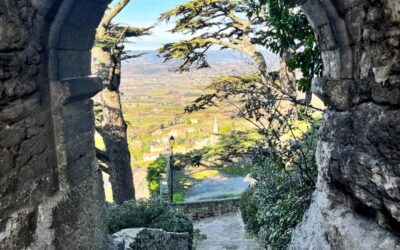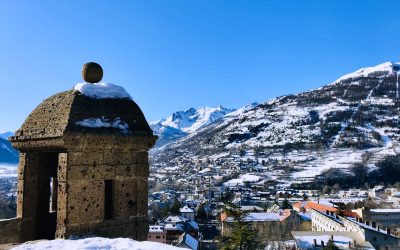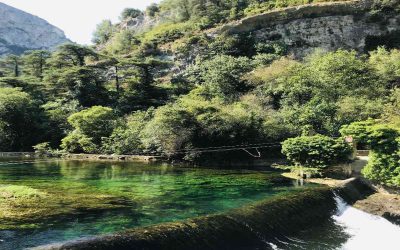Avignon is one of those cities in Provence that French locals flock to, while foreign tourists drive right past. This fortress city in the South of France is about 1.5 hours away from the Côte d’Azur (French Riviera).
It is most famous for being the temporary home of the Catholic popes, who were based there in the 13th century, instead of in Vatican Rome. (The Popes were not there entirely voluntarily, more on that later!)
With many famous sights like the Palais des Papes (Palace of the popes) and the Pont d’Avignon (Avignon bridge), Avignon is one of those hidden historical gems in Europe. And I don’t just say that because I have family in the area, and am obviously biased!
Beyond the history, the city also holds an annual theatre and performance festival for 3 weeks every July, known as the Festival d’Avignon that attracts visitors worldwide.
If you have a few days to spend, I highly recommend staying in Avignon for a couple of days. There is plenty to do in the area, so let’s get to it, shall we? Allons-y!
History
Located on the shores of the river Rhône, Avignon dates back to the 6th century B.C. It is about 1.5 hours away from Marseille, which at the time was a major port city to the Greeks and Romans and a gateway into Western Europe. Those early invaders loved wine, and the area around the Rhône river was perfect for vineyards.
But it really became famous when French King Philippe le Bel (Philip the beautiful) in 1309 “convinced” the Catholic popes that they should reside in Avignon, instead of in Rome. At the time, Avignon was part of the Kingdom of Arles and the Holy Roman Empire, not France. It was, however, much closer to Philippe than the Vatican was, and easier for him to control.

King Philippe le Bel was also the guy who, at the same time, dismantled and tortured to death the Knights Templars, so there were not many people who could contest his authority.
Known as the Avignon papacy, 7 popes resided in Avignon for a period of 73 years, building castles and fortresses and bringing much wealth in the area.
The Popes even established the famous Châteauneuf-du-Pape wine in the area, one of the French wines that is known worldwide today.
The Catholic Papacy eventually moved back to Rome under Pope Gregory XI who was later canonized as a saint. But the splendor of Avignon’s walled city and cobblestone streets remains to this day. You can read more about French history here.
These days Avignon is a lively city, attracting tourists from all over the world. In addition, it is close to plenty of other provençale villages like the antique town of Isle-sur-la-Sorgue and the Fontaine de Vaucluse, making it a very convenient base for visitors to the area.
Things to do in Avignon
1. Palais des Papes
At the top of the list for visitors in Avignon is the former Papal Palace. Given the controversy over the papal move to Avignon, it is no surprise that the palace is built as a fortress on a small hill, with high walls surrounding it and the city.

Constructed in the 13th century, the Palace is still one of the largest gothic medieval buildings in Europe and a French landmark for the ages.
The palace gradually deteriorated after the popes left in 1377, and was even used as military barracks and a prison by Napoleon Bonaparte as he went around conquering Europe.
Today, it is an exhibition center holding concerts and performances all throughout the year, as well as remaining a museum that tourists can visit.
If you are visiting, do check that there are no special events going on that restrict access to visitors. The inside is rather sparse in terms of furniture, but its large halls and 24 rooms are impressive nonetheless. There is also a beautiful church to visit in the palace, as well as expansive views across to the Rhône river which is right next door.
2. Pont Saint-Bénézet
From the Palais des Papes, you will notice a small broken bridge in the distance, across the Rhône river. The Pont Saint-Bénézet is most famous for being the subject of a children’s song in French, the Pont d’Avignon (“pont“meaning “bridge”).

When you visit the bridge (the entrance is on a street just off the Palais des Papes), you will likely cross small children and even adults holding hands in a circle and doing a little dance, as they sing the song. Basically, it is similar to the English nursery rhyme “Ringa Ringa Rosie” (without any inference to the plague!)
| FRENCH SONG LYRICS | ENGLISH TRANSLATION |
|---|---|
| (Refrain) Sur le pont d’Avignon, L’on y danse, l’on y danse, Sur le pont d’Avignon L’on y danse tout en rond. | (Refrain) On the bridge of Avignon, We dance there, we dance there, On the bridge of Avignon We dance there in circles. |
The original wooden bridge was constructed in the 12th-century to cross the Rhône from Avignon to the city across, Villeneuve-lès-Avignon. This bridge was destroyed during the Cather crusades in the area in the 13-century and then reconstructed in stone.
Once reconstructed, the bridge became very popular with locals looking to escape the Avignon crowds and pollution. The bridge was so popular, a toll was required to cross, and the drawbridge to the bridge was closed every night to prevent people crossing illegally (as well as the risk of invasion).
The Avignon cardinals had built homes in Villeneuve-lès-Avignon, making the area quite exclusive and a playground for the bridge. However, the fast-moving waters of the Rhône meant that the bridge repeatedly suffered damage during floods, with its arches collapsing several times.
Substantial repairs were needed regularly, with the city of Avignon finally giving up on the bridge when in collapsed in 1669 after another flood.
The bridge that we see today is the remains after that collapse, with some repairs to maintain stability. Today, you can access the bridge for around €5/person, and do the Avignon dance yourself!
3. Place du Palais & Place de l’Horloge
Just off the Palais des Papes is the central square the Place du Palais. A large expansive space, it offers excellent views from all angles of the palace, as well as a handful of restaurants and cafés.

About 100m away is another larger square, the Place de l’Horloge (Place of the Clock). This is the center of Avignon. Lined with restaurants and cafés, the central square is filled with outdoor terraces for additional seating for the surrounding restaurants.
All around are shops and even the town’s Hotel de Ville (Townhall). There is even an ornate gold-gilded merry-go-round at one end for the little ones.
4. Rue des Teinturiers
About a 15 minute walk away from Place de l’Horloge is boho quartier (neighborhood) of Rue des Teinturiers. With the Vaucluse Canal on one side, this street used to be the center of Avignon’s silk-spinning industry, lining the streets between the 13-18th centuries.

“Teinturiers” means “dyer” for the coloring manufacturers that used to use the waterwheels still visible today to condition their silks. Today, the area is lined with small cafés and is the perfect place to have an evening apéro.
If you are interested in learning more about Avignon’s silk industry, head over to the nearby Mont de Piété and the Silk Conditioning Mill Museum which is about a 10-minute walk away.
5. Basilique Saint-Pierre d’Avignon
Just footsteps from the Place de l’Horloge is the Basilique Saint-Pierre d’Avignon, one of the main churches in Avignon.
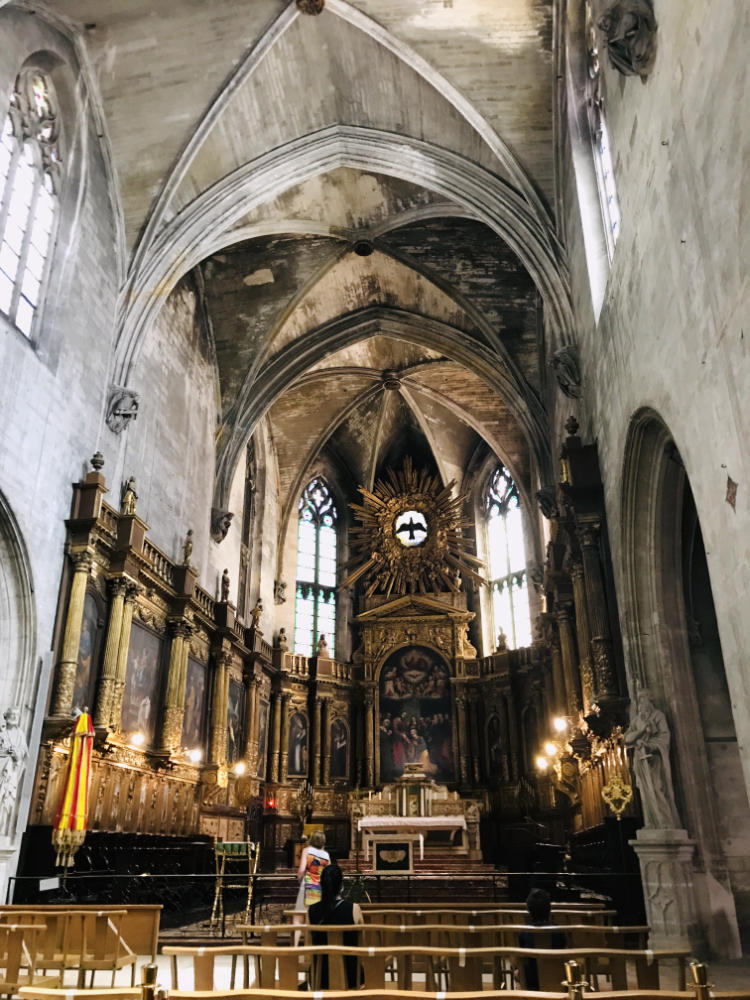
Constructed first in the 7th century and then rebuilt in a gothic style in the 1300s, it is filled with wooden carvings and ornate decor collected over the centuries. It also holds the 15th-century relics and robes of Saint-Pierre de Luxembourg.
6. Île de la Barthelasse
In between Avignon and Villeneuve-lès-Avignon is a small park-island known as Île de la Barthelasse.

Every few years it floods entirely, so there are very few houses and buildings on the island. If you are looking for a beautiful park and some lovely orchards to wander around, be sure to head over and take a picnic basket.
7. Musée du Petit Palais
Near the Palais de Pape is the Musée du Petit Palais, a 14th-century building that was known as the Small Palace. The building fell into decline after the departure of the popes, and even became a Catholic school up to the 1960s. (I have relatives who went to school here.)

Mariotto di Nardo at Musée du Petit Palais
Today it is a museum and art gallery with many works from Italian and French artists from the early Renaissance era. With over 800 paintings and sculptures, it is a wonderful way to spend a few hours.
8. Pont du Gard
About 25 km (15 miles) away from Avignon is an ancient Roman aqueduct known as Pont du Gard. Built over a period of 5 years in the 1st century, the aqueduct was built to carry water to over 50 km (31 miles) to what was then the Roman colony of Nimes.
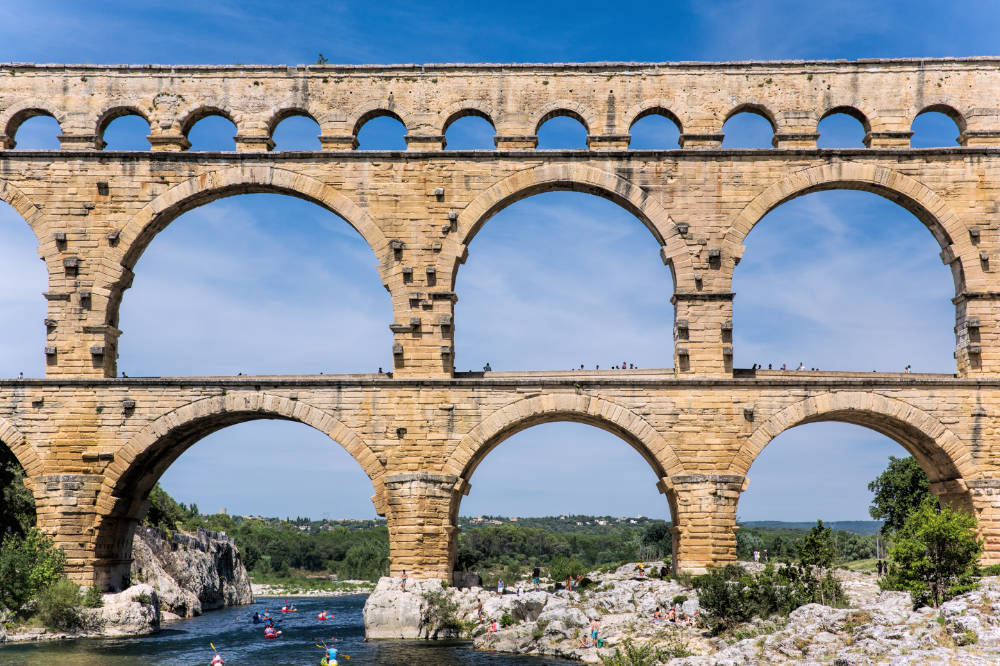
With 3 tiers of arches, it crosses the river Gardon and is the highest of all Roman aqueduct bridges, as well as being one of the best-preserved.
After the Roman empire collapsed, the Pont du Gard remained in use as it also served as a toll bridge for people looking to cross the river. The bridge remained mostly intact, with the Ducs of nearby Uzès being responsible for maintaining the bridge.
Rather than delivering water, the bridge instead became a tourist attraction, with everyone from French Kings to apprentice masons making their way to the bridge to admire its architecture.
In the early 2000s, traffic around the area was rerouted to preserve this UNESCO world heritage site and from pollution and maintain the tranquil nature of the area. Today, it is one of the most popular destinations in France after the Palace of Versailles and Mont Saint Michel.
You will need a rental car to visit, or alternatively you can book a tour from Avignon. You can read more about Pont du Gard here.
9. Day trip to Uzès
The Popes of Avignon may have departed, but the Ducs of Uzès are still around. About 45 minutes from Avignon is the charming little duchy of Uzès, complete with its own castle and ducal family.
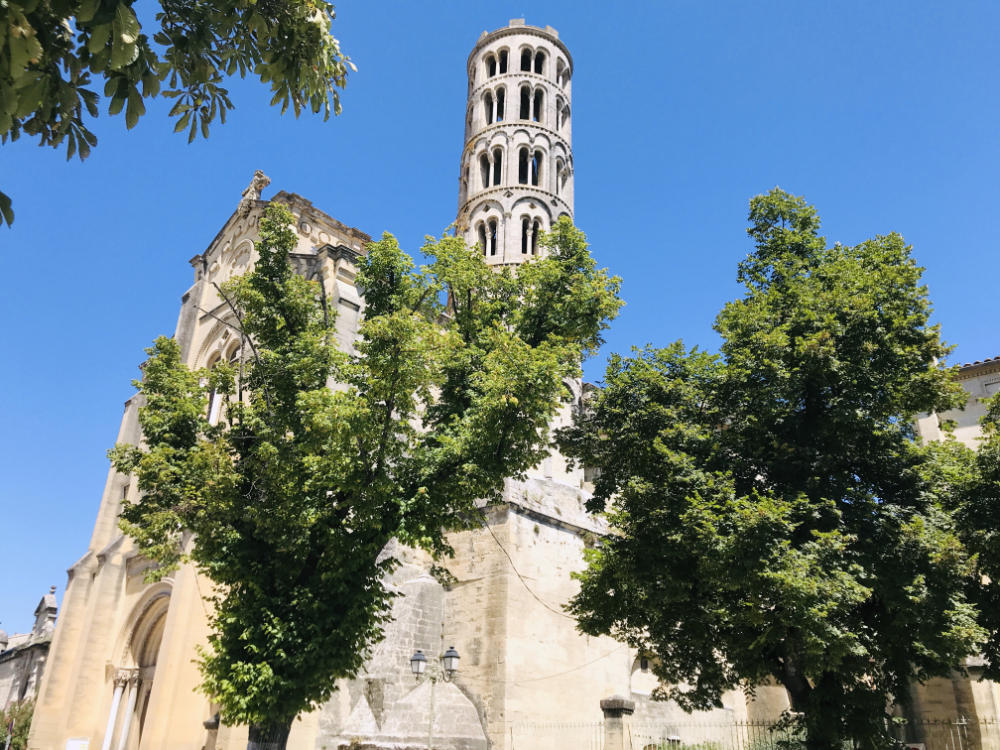
At one time the Dukes of Uzès were the highest title in the land, coming in just after the French royal family. The family managed to survive with their heads during the French Revolution, and bought back their castle in the 1800s and restore it to its former glory.
Today, you can visit the castle, which is at once a home, a museum, and a performance hall. (We managed to see the Duke and his family there at a concert during the summer holidays).
But the real attraction is the town. With charming cobblestone streets and large squares packed with cafés and shops, Uzès is a smaller, more intimate version of Aix-en-Provence. The streets are lined with utterly chic art galleries and high-end restaurants known for their gastronomy.
You will need a rental car to get there, or you can book a tour with transport from Avignon. You can read more about Uzès and other day trips from Avignon here.
10. Wine from Châteauneuf du Pape
You can’t go all the way to Avignon and not have some wine. The city is surrounded by vineyards carrying the Côtes du Rhône appellation, with labels from Luberon, Uzès, Ventoux, and more.
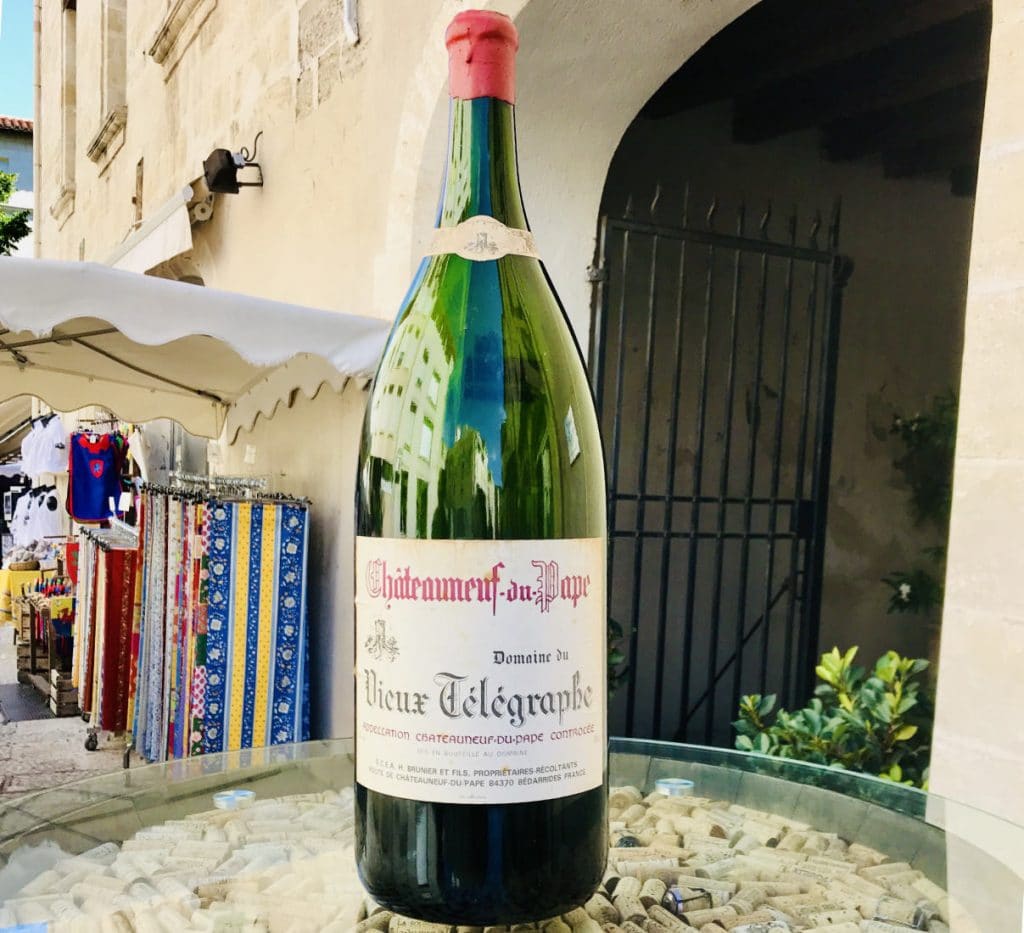
And don’t forget the famous Châteauneuf du Pape which is one of the most popular French wines sold around the world. The village is about Châteauneuf-du-Pape is about 10 miles (16km) away from Avignon, and there are many tours that will take you to visit the vineyards.
☞ READ MORE: Côtes du Rhône wines: The Sun-drenched Vineyards
The name translates to “Pope’s new castle”, and it is named for the castle that was built in the area by the Avignon Popes as their summer residence. The actual village and vineyards of Châteauneuf du Pape are about 25 minutes away by car (such distances took longer to cover back then!)
Only the facade of the castle remains these days, but the village itself is quite charming and surrounded by vineyards.
There are several tours (with wine tastings) leaving from Avignon, which I highly recommend, especially to avoid drinking and driving. You can read more about local foods and drinks to try in Provence here.
Visiting during the Festival d’Avignon
If you are visiting Avignon in the summer, you should know that Festival d’Avignon is held every July for around 3 weeks. With hundreds of official and unofficial shows, the city is packed during this period. It is the summer holidays in France, and French people from around the country flock to the city to take in a piece of theatre or performance art.
If you don’t enjoy crowds, I should warn you, this is not the time to visit. In addition, most of the shows are in French. But in terms of atmosphere, this is an electrifying time to be in Avignon. Actors, singers, musicians, and even clowns fill the streets giving snippets of their acts, hoping to encourage audiences to buy a ticket to the show. You won’t walk more than 3 minutes before crossing yet another act that is hoping to entertain.
If you do plan to visit, be sure to book your hotel early as accommodation is usually filled up months in advance.
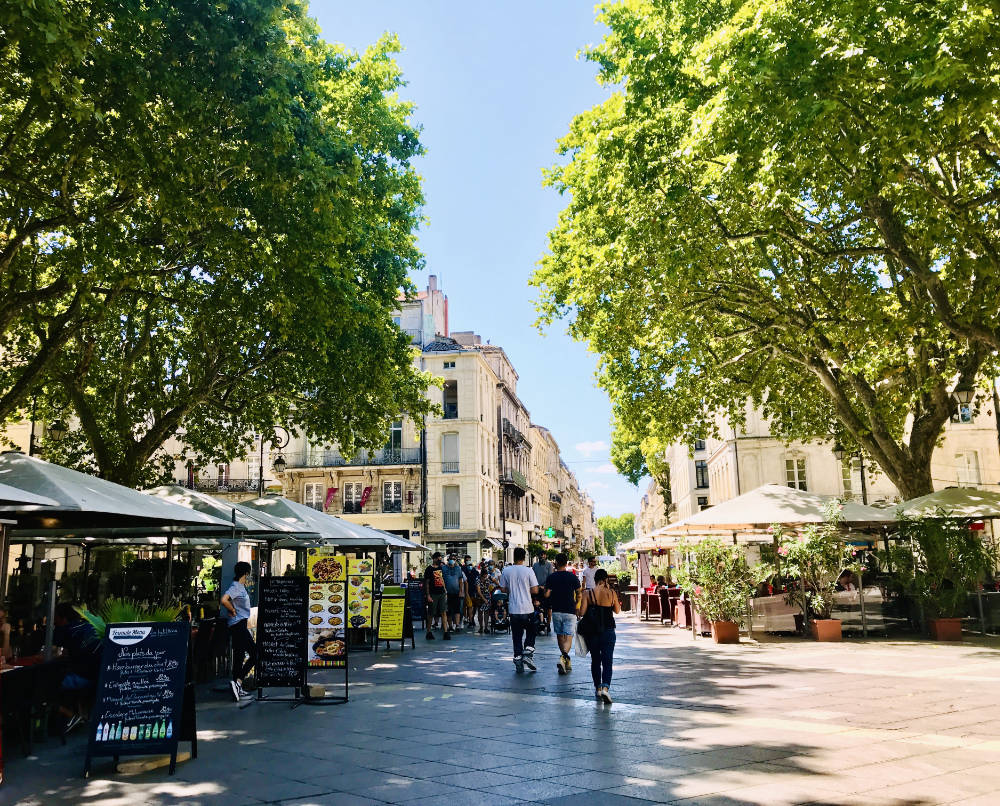
How to get to Avignon?
If you are coming from Paris, the easiest way to get to Avignon is by high-speed TGV train. The train takes around 2h45min from Paris and has connections from other major cities across Europe.
If you intend to drive, it takes around 6.5 hours from Paris (without stops). It is about 1 hour away from Nimes and 1h15 from Montpellier by car. The closest large airport is in Marseille, from where you can take a 35-minute train or one hour by car.
How many days should you spend?
There is enough to see in Avignon that I recommend spending at least 2 nights. This large walled city in Provence has plenty of culture, nightlife, and sightseeing to make it an ideal destination to spend a few days.
In addition, there are many small towns within an hour that are lovely to visit like St. Remy de Provence, Baux de Provence, Roussillon, etc.
Where should you stay?
I highly recommend staying within Avignon city walls to get a true feel of the city. The entire walled city is very walkable, so you will enjoy leaving the car/public transport behind!
The area around the Palais des Papes is quite lively, so book early, especially if you are visiting during the festival in June.
- €€€ – Kyriad Avignon – Palais des Papes
- €€€€ – Hôtel de l’Horloge

So will you be adding Avignon to your France bucket list? If you enjoyed that article, you may like to read more about traveling around Provence. A bientôt!

